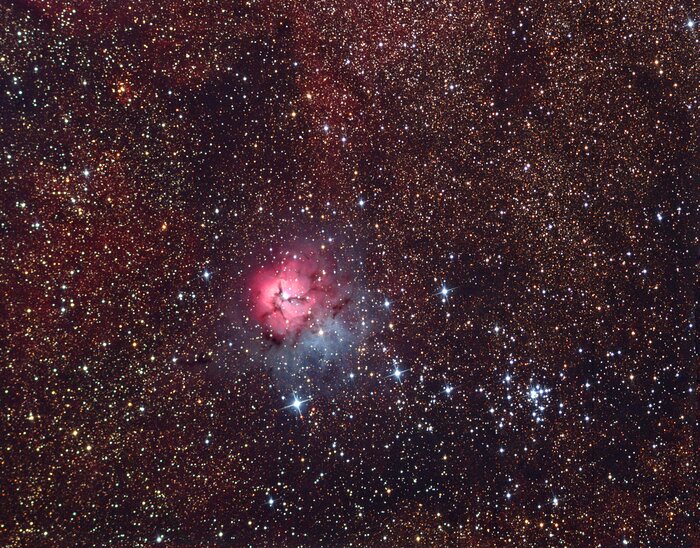The Trifid Nebula, also known as Messier 20 (M20), is a stunning celestial object located in the constellation Sagittarius, and situatred approximately 5,200 light-years away from Earth. It’s a famous emission nebula, meaning it emits light due to the excitation of hydrogen gas within it.
It was discovered by the French astronomer Charles Messier in 1764, who designated it as Messier 20 (M20) in his famous catalogue of non-cometary objects. Here’s some more information about this deep-sky object (DSO):
Appearence and Composition
The Trifid Nebula gets its name from the dark lanes of dust that divide it into three distinct sections, giving it a trifurcated appearance when viewed through telescopes. These dark lanes of dust are actually thick molecular clouds that block the light from behind them. These dust lanes are primarily made up of interstellar dust particles, which consist of tiny solid grains of carbon, silicates, iron, and ice compounds.
Like many other emission nebulae, the Trifid Nebula primarily consists of hydrogen gas, along with other elements such as helium, oxygen, sulphur, and nitrogen. These elements are crucial for the formation of new stars within the nebula. The nebula glows brightly due to the emission of radiation from the young stars embedded within it, causing the surrounding gas to fluoresce.

Star Formation
The Trifid Nebula is a stellar nursery, where new stars are being born from the surrounding gas and dust. Within its glowing clouds, young and massive stars are actively forming. These stars emit intense ultraviolet radiation that ionizes the surrounding hydrogen gas, causing it to glow brightly.
Nebula Classification
The nebula is classified as both an emission nebula and a reflection nebula. The emission nebula part refers to the glowing hydrogen gas, while the reflection nebula part refers to the blue reflection nebulae that surround the bright emission regions. These reflection nebulae are caused by starlight being scattered off of dust particles.
Observation
M20 is a popular target for amateur astronomers due to its brightness and distinctive appearance. It can be observed with binoculars under dark skies with relative ease, while telescopes reveal more intricate details and structure.
The Trifid Nebula is best observed during the summer months from the Northern Hemisphere, particularly from June to August, when its host constellation, Sagittarius, is high in the sky. Visibility peaks in July and August.
In the Southern Hemisphere, the nebula is visible during the winter months from May to September, with the best viewing period being around June and July. Sagittarius is higher in the sky for southern observers, giving them a greater advantage over observers in the Northern hemisphere.




